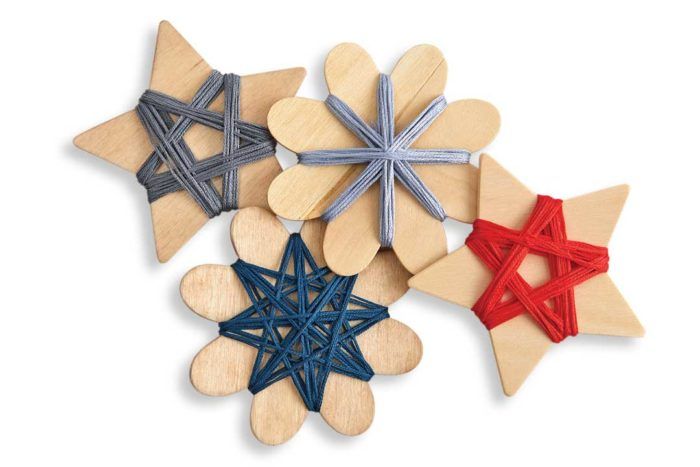
Floss bobbins, which can be used to store floss or pearl cotton, come in decorative versions made of plastic, heavy cardboard, wood, or mother-of-pearl. For an attractive and inexpensive alternative, make your own from the thin wooden cutouts sold in the woodcraft section of craft stores. The cutouts are perfect for wrapping thread. I especially like the flower shapes, but others, such as the star, would also work. Sand the edges and faces to reduce the chance of the thread catching, and then rub in some wood polish. Once the polish dries, the cutout is ready to hold thread.
—June Albright, North Hartland, Vermont
Ease with serging
I always dreaded sewing narrow, curved hems that require easing. Most pattern instructions suggest machine-basting 1/4 inch from the raw edge and easing in the fullness. I find this method to be time-consuming, and I was not always pleased with the result. I have recently found that if I serge the hem edge with a three-thread overlock stitch and set the differential feed setting to 1.8, the fabric is eased without fuss. Then I complete the hem as desired. Note: The differential feed setting varies depending on the weight of the fabric.
—Yvonne Belton, Winnipeg, Manitoba, Canada
Darts without dimples
I found a way to prevent a dimple forming at a dart’s tip. It’s quicker than tying the threads and less bulky than backstitching at the tip. Stitch the dart with your machine’s default stitch length until you are an inch from the point. Then stop and shorten the stitch length dramatically—I use 1.0 mm—and sew until you reach the dart point. Continue stitching off the fabric beyond the dart point to create a chain. Leaving some slack in the thread chain, make a few final stitches in the dart value instead of knotting or back-tacking the thread. Remember to readjust the stitch length before beginning the next dart.
—Gayle Clason, Medford, Oregon
New use for a baking tool
When using fusible interfacing, I found myself with lines of adhesive on my pressing surface that I worried would adhere to the next thing I ironed. To solve this problem, I used a silicone baking mat to cover the pressing surface. I have several of these mats that I lay edge to edge when I need to fuse large pieces or many pieces at one time. Not only can you fuse pieces you’ve already cut, but you can also block-fuse a number of small pieces at once like this. Lay the fabric pieces right side down on the mat, leaving a narrow gap between them. Cut a piece of fusible interfacing large enough to cover all the pieces, then fuse according to the interfacing instructions. Because the fusible’s adhesive does not stick to the mat, you can then lift the whole sheet of interfacing and trim the pieces apart.
Another use for silicone baking mats is as pressing guides to hem garments. I trimmed the edge o a mat to form a perfectly straight, sharp edge. Then, with a fine-point permanent marker, I drew straight lines parallel to the edge at common hem depths. This template doesn’t get soggy from the iron’s steam like the manila folder strips I used in the past.
The mats are easy to store in a small space. Just roll them up and slide them into a small cardboard tube, or wrap a rubber band around them. I stand mine in a jar with other frequently used pressing aids next to my ironing station.
—Connie Murdoch, Thunder Bay, Ontario, Canada
Repurpose serger scraps
The dress and pantaloons I was making for my granddaughter called for a fabric flower. Instead of using the method in the instructions, I decided to make use of the narrow strips cut off the seams when I had serged the garments.
Using stiff crinoline as a base, I wove the strips in and out of the base in the approximate shape of a circle, securing them with a tapestry needle. I then cut a small felt circle and trimmed the base of the flower to the same size. Once glued to the felt, the flower was easy to tack onto the dress and could be removed for cleaning. It made good use of leftover scraps and matched the dress’s fabric better than a store-bought embellishment.
—Maril Adrian, Carlsbad, California
Makeshift thimble
I had tried every type of thimble on the market and never found one that felt comfortable. When I embarked on making a fully tailored winter coat, I realized I needed some protection for my fingertip. I started using a dab of super glue on my finger to create a tiny but tough bit of coverage. The glue thimble stays in place and moves naturally with my finger. Once I was done sewing for the day, I just peeled it off and threw it away.
—Erin Beauchamp, Warrenton, Virginia
Helpful crochet hook
I recently purchased a sewing machine with a needle threader. However, I have trouble pulling the threaded loop through the needle’s eye; I often unthread it instead. I looked around and found an instrument to catch the loop: My no. 13 steel crochet hook was perfect. I hook the loop to pull the end through. Then I use the crochet hook to pull the bobbin thread up from under the presser foot. When I needed to wind a bobbin, I struggled to pull the thread end through the hole in the bobbin. The crochet hook fits through the hole and grabs the thread without a problem.
I also found that a crochet hook is an easy tool with which to remove basting threads. On certain fabrics, it slips under the thread without catching a fabric thread as a sharp point does.
—Lois Phillips, Drexel, Missouri



































Log in or create an account to post a comment.
Sign up Log in